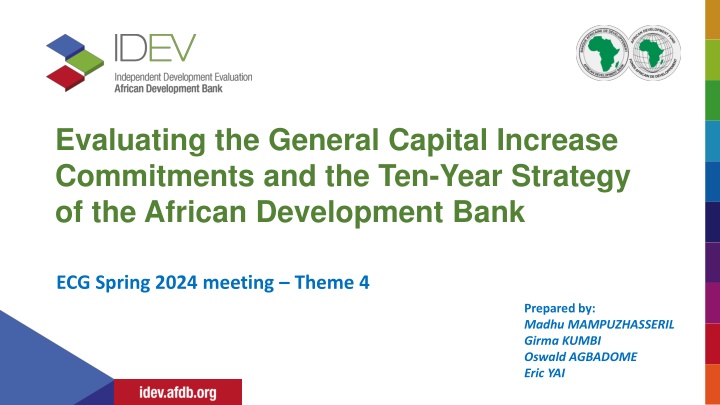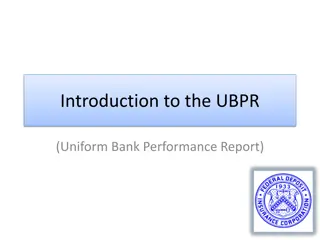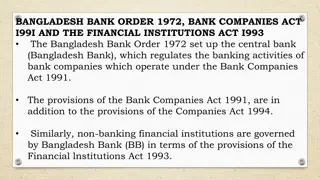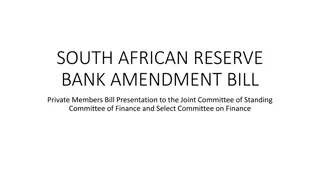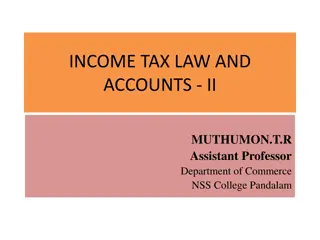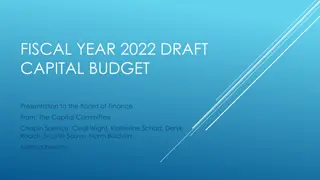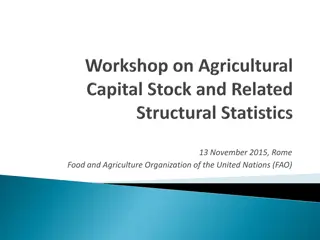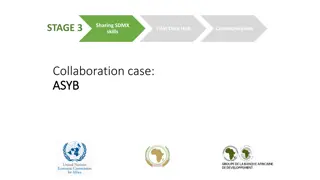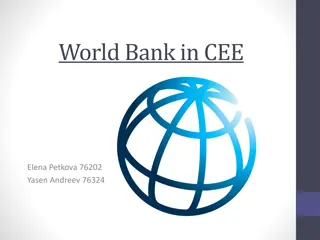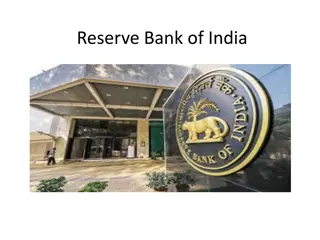Evaluating African Development Bank's Capital Increase and Ten-Year Strategy
This evaluation delves into the commitments and strategies of the African Development Bank, focusing on the General Capital Increase and the Ten-Year Strategy. It covers objectives, methodologies, limitations, and recommendations, aiming to analyze the efficiency and effectiveness of the bank's corporate initiatives. The approach includes theory-based methods, expert panels, and benchmarking with other MDBs. Clustering commitments into key areas allows for a comprehensive assessment of the bank's policies, operations, resources, and institutional effectiveness.
Download Presentation

Please find below an Image/Link to download the presentation.
The content on the website is provided AS IS for your information and personal use only. It may not be sold, licensed, or shared on other websites without obtaining consent from the author.If you encounter any issues during the download, it is possible that the publisher has removed the file from their server.
You are allowed to download the files provided on this website for personal or commercial use, subject to the condition that they are used lawfully. All files are the property of their respective owners.
The content on the website is provided AS IS for your information and personal use only. It may not be sold, licensed, or shared on other websites without obtaining consent from the author.
E N D
Presentation Transcript
Evaluating the General Capital Increase Commitments and the Ten-Year Strategy of the African Development Bank ECG Spring 2024 meeting Theme 4 Prepared by: Madhu MAMPUZHASSERIL Girma KUMBI Oswald AGBADOME Eric YAI
OUTLINE INTRODUCTION EVALUATING GENERAL CAPITAL INCREASE (GCI) COMMITMENTS Objectives, questions and scope Approach and methodology Limitations and mitigation strategies Ratings and Recommendations EVALUATING CORPORATE STRATEGIES (focus on TYS) Overview of strategic framework (2013-2024) Importance of evaluating corporate strategies Methodological insights Ten-Year Strategy Ratings, Lessons and Recommendations
Introduction SELECTED RECENT CORPORATE EVALUATIONS General Capital Increases (GCI): Evaluation of GCI-VI and ADF 12&13 commitments (2015); Forthcoming evaluation of GCI-VII commitments (to start in 2024). Corporate Strategies: Comprehensive Evaluation of Development Results (2016); Evaluations of the Bank s Development and Business Delivery Model (2019); Ten-Year Strategy 2013-2022 (2022); Decentralization (ongoing); One Bank Approach (ongoing). HIGH 5 & DBDM CEDR TYS ADF 12 (2011- 2013) EVALUATION 2004-2013 2013-2022 GCI-VI and ADF 12-13 EVALUATION ADF-13 (2014- 2016) ADF-14 (2017- 2019) GCI-VI 2010 2011 2012 2013 2014 2015 2016 2017 2018 2019 2020 2021 2022 2023 2024 TYS DBDM EVALUATION ONE BANK APPROACH TYS EVALUATION 2013-2022 2024-2033 GCI-VII ADF 16 (2023- 2025) ADF-15 (2020- 2022)
Evaluating General Capital Increase Commitments Evaluation Questions Scope Objectives Combine an evaluation of the capital increase (GCI- VI) and replenishment (ADF-12 & 13) processes, delivery and implementation. Period: 2010-2014 Covering all three processes, it tracks delivery on more than 100 commitments. ADF delivery period was ongoing at time of the evaluation. 1. Relevance commitments challenges and priorities; of the the agreed Bank s Draw conclusions and lessons from the implementation of commitments made by Management during the capital increase (GCI-VI) and replenishment of ADF- 12 &13, and make recommendations to improve in each of these areas to 2. Efficiency of the processes in reaching agreement on a coherent and realistic commitments; portfolio of 3. Delivery (outputs establishment of new structures or processes); of such the commitments documents, as 4. Effectiveness of their subsequent implementation
Approach and Methodology Theory-based approach: Document and literature review. Key informant interviews, focus groups, electronic surveys, and case studies. Use of an expert panel. Process mapping, review of organizational models. Benchmarking with other MDBs assumptions, inputs, outputs, outcomes, and impacts, according to its indicative results monitoring framework Accountability and learning purpose Clustering the commitments around five areas: (i) policies and strategies; (ii) operations; (iii) resources and financial management; (iv) institutional effectiveness; and (v) results measurement. Harness intersecting evaluations/studies: Coordinate with two other parallel evaluations (i) policy and strategy making and implementation, and (ii) management of the administrative budget.
Approach and Methodology Document and literature review Key informant interview ADF Replenishment meeting programs and agendas Papers prepared for the replenishment meetings Chairman s summaries of replenishment meetings Deputies/replenishment reports Minutes of Bank steering committee meetings MTRs Record of GCI-VI meetings GCI-VI annual reports to Governors, mid-term reviews Documents related to the delivery of commitments Semi-structured interviews with a broad range of internal and external stakeholders. The interview templates were designed to obtain qualitative insights as well as structured responses deploying a rating scale. Interviewees were selected to ensure adequate coverage of people involved in all three stages of the replenishment and commitment process. Some internal interviewees were identified based on their broad knowledge of the processes, others because of their deeper involvement in specific areas affected. Externalinterviewees included a sample of officials from member countries, including ADF and non-ADF members and chairpersons and former senior managers who led the process internally.
Approach and Methodology Benchmarking Expert panel review Electronic survey All GCI-VI, ADF-12 & 13 commitments were assessed by an expert panel, which looked into: Realism of specific commitments and their timelines; Diagnosis of the underlying challenges; Alignment with the priorities of the Bank; Clarity with respect to the intended change; and Extent to which commitments are at a strategic level. The expert panel was composed of independent experts with related previous experiences. Several elements of the evaluation utilized benchmarking organizations. Surveys to seek the views of: The ADF deputies and their alternates or advisors; and The Executive directors and their advisors. Each questionnaire targeted and addressed areas that are specific to each group. Response rate was low (31- 32%). with peer Process/cycle characteristics (length, number of meetings, meetings, number of papers prepared, elapsed time); location of Number of commitments; Coverage of commitments; Financial including size of donor contributions; and resources mobilized, Monitoring and reporting arrangements. The organizations: those that are the most comparable (WB, IFAD). choice of benchmark AsDB, IADB,
Limitations and mitigation strategies Limitations Mitigation Unavailability of some documents. Inadequacy of cost data for the evaluation period. Turnover of key donor representatives, executive directors, and staff and managers, in light of the time elapsed since ADF-12 and GCI-VI. Low survey response rates. Lack of implementation and outcomes data Triangulation of evidence sources: The report makes clear what lines of evidence support the findings presented and where there is insufficient evidence to draw definitive conclusions. Clustering of commitments around 5 areas to improve consistency and reporting on outcomes. Harnessing on other parallel evaluations to investigate and fill gaps.
Recommendations For the ADF specifically: For both ADF and any future GCIs: 1. Focus on fewer and more strategic commitments, with realistic timelines and estimated costs for delivery. Enhance monitoring and managerial accountability for effective performance and results in terms of continued implementation, not only one-off deliveries. 3. Simplify the process. 4. Seek early Board ownership of commitments. 2. Management s Response to Recommendations: 1: Agreed; 2: Agreed; 3: Agreed in part; 4: Agreed. With Action Plans for Implementation.
EVALUATING CORPORATE STRATEGIES AfDB Strategic Framework 2013-2024 High 5s DBDM OBA TYS 2.0 2024 TYS 2013 2016 2016 2020 DBDM (Development and Business Delivery Model) 2016: Introduced to improve the Bank s efficiency and effectiveness in delivering its TYS priorities. Enhances operational effectiveness and organizational efficiency by decentralizing and moving closer to clients. Ensures strategic alignment across all operational activities, prioritizing country-specific needs and agile response to changes. TYS 2013-2022 (2013) Long term strategy with a focus on inclusive and green growth for Africa's transformation. Lays out the roadmap for achieving The Africa We Want by 2023. Aim at achieving substantial impact by deepening the development of infrastructure, regional economic integration, private sector development, governance, and accountability. One Bank Approach 2020 Clarifies organizational model and streamlines AfDB functions, roles/responsibilities across HQ and regional/country offices. Enhances operation quality with in-depth technical knowledge and quality control. Prioritize client delivery through Business Delivery Units and aligns diverse units with shared objectives for collaboration and results. High 5s (2016) Accelerate TYS with 5 key goals: Energy, Food, Industry, Integration, and Quality of Life. Align with SDGs for broader impact. Strategically allocate resources for targeted projects. Set and track progress with clear KPIs through a revised RMF.
EVALUATING CORPORATE STRATEGIES IMPORTANCE OF EVALUATING CORPORATE STRATEGIES Thorough evaluation of strategies like TYS and DBDM are crucial to evolve management practices and prepare new strategies. Evaluation of the implementation of the DBDM (2019) DBDM (2016-2018) IDEV has undertaken a systematic evaluation approach through its three-year work program. Evaluation of the implementation of the TYS in 2022 Evaluations follow the implementation cycles of most strategies (TYS) or respond to specific requests of governing bodies (DBDM). TYS (2013-2022) High 5s (2016 2022) These evaluations aim at providing evidence- based recommendations, enhancing learning and accountability, andensuring continuous stakeholder engagement on key policies and strategies Evaluations of Organizational reforms in the AfDB (2023- 2024) / Ongoing Decentralization Program (2015-2023) One Bank Approach (2020-2023)
Methodological insights Ten Year Strategy Evaluation TYS: Objectives & Purpose Evaluation Methodology Purpose: Evaluation Basis: Theory-based, leveraging a reconstructed Theory of Change for the Ten- Year Strategy (TYS). Mixed Methods for Validity: Utilized both quantitative and qualitative approaches for comprehensive triangulation and validation. Criteria Assessed: Focus on relevance, coherence, effectiveness, and efficiency. Impact and sustainability criteria excluded due to evaluability and data concerns. Portfolio Review : Analyze time series of RMF indicators (2013-2016, 2016-2025) to assess TYS effectiveness and efficiency. Collect and analyze additional data on AfDB portfolio composition (2005-2021). Provide an independent assessment of TYS implementation. Offer lessons and recommendations for the next Ten- Year Strategy (2023 2032). Objectives: Accountability: Assess the TYS's relevance, effectiveness, and implementation efficiency over the past decade. Learning: Draw lessons from the TYS implementation to inform future strategies. Scope: Covers TYS implementation from 2013 to June 2022. Includes the High 5s Agenda, RMFs for 2013 2016 and 2016 2025, and the DBDM as key elements. Focuses on the effectiveness of the TYS as a programming framework and the Bank's overall institutional performance and delivery quality. Exclusions: Does not assess the achievement level of TYS's overall objectives (Inclusive Growth and Green Growth).
Methodological insights (contd.) Evaluation Methodology Limitation and Response Data Variability: Inconsistencies in AfDB data sources. Response: Collaborated with relevant departments for data verification and reconciliation. Evaluation Timeline Mismatch: Evaluative documents not aligning with TYS timeframe. Response: Prioritized evaluations within TYS period, acknowledging timeline constraints. Lack of TYS-Focused Statistics: Missing detailed statistics by TYS priorities. Response: Utilized available sectoral and High 5 data, interpreting with respect to TYS goals. Survey Participation: Low response rate from RMC surveys. Response: Enhanced analysis with additional interviews to offset survey limitations. Synthesis of Evaluative Knowledge: Leverage existing IDEV evaluations, PCREN and XSREN for a strong evidence base. Focus on effectiveness, efficiency, relevance, and coherence of the TYS. Consultation Strategy: Individual interviews with AfDB staff and partners. Focus Group Discussions (FGDs) across stakeholder categories. Surveys targeting relevance, coherence, and efficiency criteria. Selected case studies for in-depth analysis on effectiveness and beyond. Benchmark TYS against policies and strategies of other development organizations.
TYS Eval Ratings, Lessons and Recommendations Lessons: - Adding new priorities leads to confusion, disruption, misalignment. - Explicit TOC can avoid logical gaps and confusion. - Alignment of RMF and TYS is crucial for strong results measurement - Matching project classification and operational priorities enables alignment & performance. - Rationalize the suite of policies and strategies for clarity and efficiency. Ratings: Relevance: Satisfactory Coherence: Satisfactory Effectiveness: - As programming framework: Partly Unsatisfactory - Delivery: Satisfactory Efficiency: Satisfactory Recommendations: 1. Ensure a robust design for the new long-term Strategy. 2. Improve the effectiveness of the new long-term Strategy by ensuring that the Bank aligns its operations with the priorities laid out in the Strategy. 3. Strengthen monitoring, evaluation, and reporting by improving institutional mechanisms and coordination. Management s Response to Recommendations: 1: Agreed; 2: Agreed; 3: Agreed. With Action Plans for Implementation
Thank you! Keep in touch with us Address IDEV AfDB, CCIA Building Abidjan, Cote d Ivoire Contact Info Email: idevhelpdesk@afdb.org Telephone Office Phone: +225 27 2026 2841 Website https://idev.afdb.org/ Twitter @evaluationafdb
